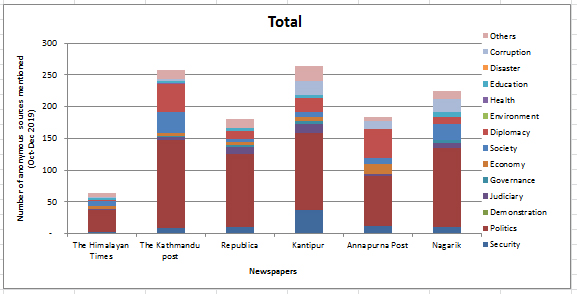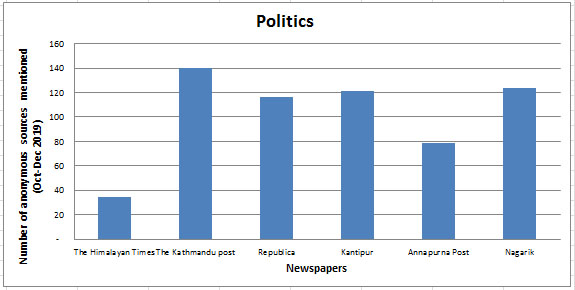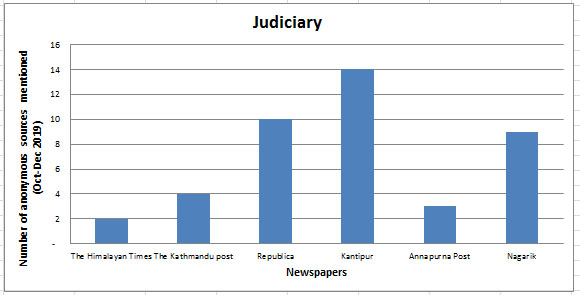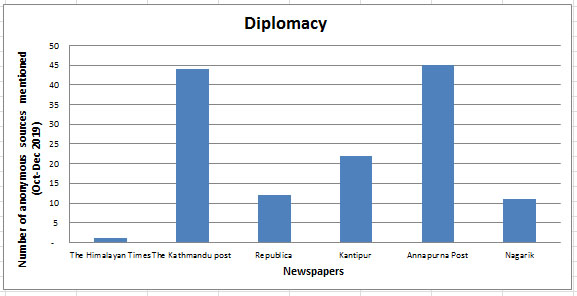Quarterly report (Oct-Dec 2019) on anonymous sources in newspapers
South Asia Check / January 6, 2020

During the three months between October 1 and December 31, 2019, among the six major national dailies that we monitor, Kantipur daily used the most number of anonymous sources in the front page reports. It used a total of 264 anonymous sources in the front page reports during the period.
South Asia Check tracks the use of anonymous sources in the news reports published on the front pages of six leading national dailies of Nepal – Kantipur, Nagarik, Annapurna Post, The Kathmandu Post, Republica and The Himalayan Times. While the first three are Nepali language newspapers, the last three publish in English.
After Kantipur, the dailies using the most number of anonymous sources included The Kathmandu Post, Nagarik, Annapurna Post and Republica respectively. The Himalayan Times used the least number of anonymous sources during the period. In the three months, it used 64 anonymous sources in its news reports.
During the three months, the front page reports of the six dailies used altogether 1,174 anonymous sources.









Most of the news reports on the front pages of the newspapers were on politics. Anonymous sources were mostly used in politics-related news reports (in 615 instances) during the period. The Kathmandu Post and Nagarik were the first and second national dailies respectively using the highest numbers of anonymous sources in their news reports related to politics — The Kathmandu Post used anonymous sources in 140 instances and Nagarik in 124 instances in such reports.
Diplomacy is the second topic in the Nepali newspapers where anonymous sources were used in highest numbers. During this period, anonymous sources were used in 135 instances in diplomacy-related news reports in the six newspapers. Annapurna Post used the highest numbers of anonymous sources in diplomacy-related news reports.
Quoting anonymous sources in news reports is normal. Regarding the use of anonymous sources in news reports, ‘Journalist’s Code of Conduct, 2016 (first amendment 2019)’ issued by the Nepal Press Council states the following:
“Source should be quoted for the reliability of the news. However, while quoting the source, the name and identity of such source should be kept confidential so as to avoid any serious damage to the source.”
The identity of news source should be protected only if revealing the source’s identity can cause serious harm to him/her.
But some news reports published during this period have quoted anonymous sources even when there is no apparent need to do so.
For example, a story headlined “Breaking the gender binary is not easy, even in census” published in an English-language daily stated the following:
“We had included an additional category “others”, besides male and female, in the last census. However, their number was limited to only around 1,500”, says an official at the CBS, adding that the CBS did not publish the number assuming that their numbers could have been under reported.
In another Nepali daily a story headlined “House and land prices falling” stated:
“There is growing tendency of taking industrial loan and investing in the real estate” said an official of Finance Ministry.
Haphazard use of the anonymous sources diminishes the credibility of news reports and the newspapers publishing such reports.
Click here to download the spreadsheet of anonymous sources statistics prepared by South Asia Check.
This material is copyrighted but may be used for any purpose by giving due credit to southasiacheck.org.
Comments
Latest Stories
- In Public Interest Covid-19 cases are low, but that’s not an excuse to avoid vaccination
- In Public Interest What is BF.7, the sub-variant that has the world by its grip?
- In Public Interest Threat of a new Covid-19 wave looms large amid vaccine shortage in Nepal
- In Public Interest As cases decline, Covid-19 test centres in Kathmandu are desolate lot
- In Public Interest Dengue test fee disparity has patients wondering if they’re being cheated
- In Public Interest As dengue rages on, confusion galore about what it is and what its symptoms are. Here’s what you need to know
In Public Interest
 Covid-19 cases are low, but that’s not an excuse to avoid vaccination
The Pfizer-BioNTech bivalent vaccines authorised by the Nepal Government provide better protection a...
Read More
Covid-19 cases are low, but that’s not an excuse to avoid vaccination
The Pfizer-BioNTech bivalent vaccines authorised by the Nepal Government provide better protection a...
Read More
- What is BF.7, the sub-variant that has the world by its grip?
- Threat of a new Covid-19 wave looms large amid vaccine shortage in Nepal
- As cases decline, Covid-19 test centres in Kathmandu are desolate lot
- Dengue test fee disparity has patients wondering if they’re being cheated
- As dengue rages on, confusion galore about what it is and what its symptoms are. Here’s what you need to know